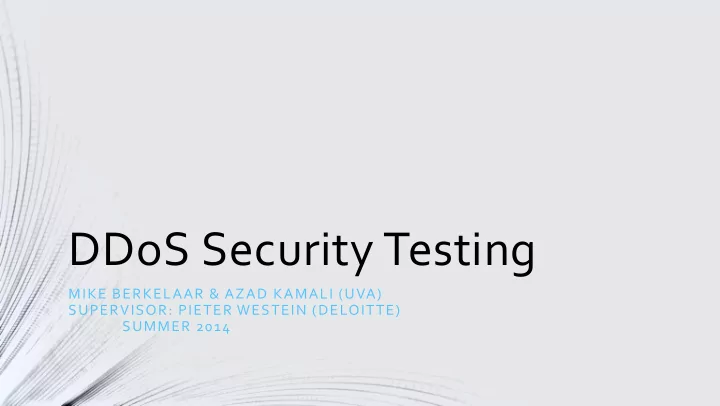

DDoS Security Testing MIKE BERKELAAR & AZAD KAMALI (UVA) SUPERVISOR: PIETER WESTEIN (DELOITTE) SUMMER 2014
A (D)DoS Attack • Is an attempt to make a service/resource unable to operate as intended • Called “ Distributed ” , when more than one attackers are involved • Comes from no where! • Distributed • Spoofed sources • Hard to differentiate from legitimate usage 2
Types of DoS • Disrupting Services • Configuration Information (DNS Poisoning) • State Information (disassociation in Wi-Fi) • Cutting Communication Path • (Over)Consuming Valuable Resources • Bandwidth • Processing Time • We will be focusing on the 2 nd category 3
Defensive Measures • Have more resources than attacker(s) (easy to say!) • Make use of some in-line filtering devices • Be prepared • Monitor behaviors • Dump logs and USE them • Test your infrastructure • What would it do under pressure? 4
Research Question • How can various DoS attacks be simulated in a controlled way? • Which DoS attacks can be simulated in a potentially controlled way? • Which parameters should be used in order to have a controlled attack? • Which metrics should be monitored to measure the effects of a DoS • Use-case • Test effects of potential DDoS attacks • Identify bottlenecks 5
Attack Layers • Network Layer • Targeting Bandwidth of target and all nodes in the path to it • Ping of death • Amplification attacks • Application Layer • Targeting Application specific aspects and/or TCP stack of OS • Massive (fake) HTTP requests • Heavy queries against Database servers • SYN Attack 6
When is the attack successful? • When target is slowed down? • When it is out for a while? • When it is completely unavailable? 7
Basic Idea • Based on feedback loops • Start a potential attack • Monitor the affects on target (get feedback) • Stop the attack at a certain point 8
Architecture • Separation of monitoring and attacking Monitoring Master agents • Distributed execution Monitoring feedback • Performance • Monitoring consensus • Extendable with various DoS attacks Attack Monitoring instructions traffic Attack traffic 9 Target Attack agents
Monitoring parts • Resources • Remaining TCP queue space • System resource utilization • Data Gathering • Resource status gathering via • SNMP • WMI • Other local daemons • RTT ( ICMP, HTTP ) • Timeouts ( ICMP, HTTP ) 10
Attack monitoring • Monitoring (un)availability is a concern • Monitoring accuracy may be off 11
Attack monitoring • Reactive • Monitor if a defined threshold is reached • ‘ Damage ’ may have been done already • Proactive • Watching trends could allow for predictions • Obvious choice if applicable • Deal with noise and variance 12
Threshold Selection • Different expectations • Performance Degradation • Partial unavailability • Complete unavailability • Thresholds used in our tests: • 1 % random packet loss • 10 x response time regression 13
Proof of concept • Python implementation of framework • DDoS simulations • Traffic flood • Application level DoS • SYN flood 14
Traffic flood • Exhaust network capacity • Monitoring acts as a part of the attack • Probes for link capacity with ICMP packets • Hands off confirmed 'capacity' to attack-agents • Sliding rate as a percentage of the total attack rate • Approximation of packet loss based on monitoring results 15
Traffic flood handoff 16
Traffic flood 17
Application layer DoS • Resource intensive script requested over HTTP • Monitor HTTP response time • Values increase with attack rate • Prediction of attack headroom based on response time slope 18
Application layer DoS 19
Conclusion • DDoS attacks are controllable, depending on: • The definition of when a DDoS causes ‘ damage ’ • The monitoring capabilities an attack class allows 20
Demo • Controlled traffic flood demo 21
Recommend
More recommend